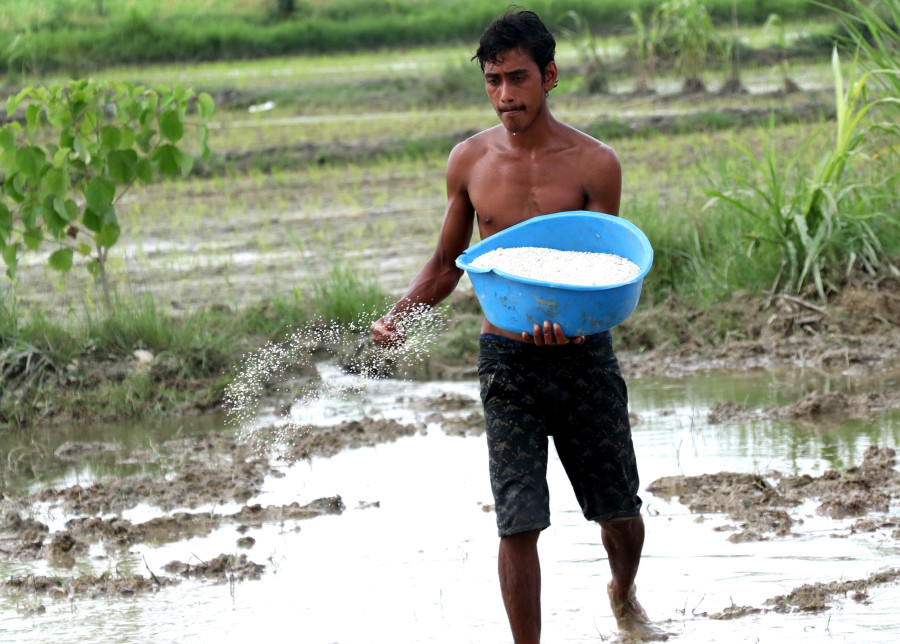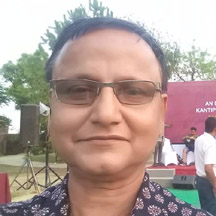Money
Farmers hit by fertiliser shortage
Frantic farmers in most of the districts in Province 5 said if nothing is done, food production may drop
Kamal Panthi, Manoj Poudel, Sanju Paudel & Rupa Gahatraj
Farmers have been hit by an acute shortage of fertiliser at the height of the paddy growing season in Province 5, one of the key foodgrain producing regions of the country.
Due to a fertiliser shortage, they are forced to buy them at an expensive rate in the open market in India which is then imported illegally. Many farmers say that fertiliser imported from bordering towns is substandard and could damage soil health but they don’t have other options.
Paddy cultivation, which used to start in mid-June, depended solely on monsoon and chemical fertiliser. The summer crop is not only a key crop cycle for farmers but is equally important for the growth of the country’s economy which largely depends on the agricultural sector.
Frantic farmers in most of the districts said if nothing is done, food production may drop.
The issue has been raised at the provincial assembly meeting but farmers’ grievances have not been addressed.
“The paddy cultivation season has started, but we haven’t received the farm’s vital input,” Tika Ram Chapagain, a farmer from Tillotama Municipality said.
The shortage of chemical fertiliser has appeared at the time when the government has announced an increase in state subsidy on chemical fertilisers by 50 percent to Rs 9 billion from the next fiscal year to boost productivity. The private sector doesn’t deal with fertiliser trade in Nepal.
Farmers like Chapagain are worried because about the fertiliser shortage as they are forced to import the vital farm input from India illegally and at great financial cost.
“Most of the time we get substandard fertiliser when we import through the porous border point,” he said, adding that it is difficult to import because police are mobilised on both sides of the border to check illegal trade.
“Most of the police release the fertiliser after farmers pays them.” Another farmer Javed Ali, who have been cultivating paddy in more than one and a half bigas of land, is worried because the seed sowing period is already delayed. After the seeds have sprouted, it is then transplanted. “I waited to get the state-subsidised fertiliser but the fertiliser warehouse of the government has already dried.” He said he was forced to import from India illegally.
Farmer Ramu Bhandari used to receive state subsidised chemical fertiliser and seeds from the cooperatives every year but this year he did not get them. He also brought and sowed paddy seeds from India. “The transplantation time has arrived but I don’t have fertiliser.”
Rajendra Karki, chief of Agriculture Inputs Company, Bhairahawa, the supplier of state-subsidised fertiliser, said that the company has been able to supply diammonium phosphate (DAP), the world’s most widely used phosphorus fertiliser, to only 60 percent of farmers. “We don’t have any stock.”
He said that due to the recent election in India and hike of fertiliser price globally, the country is currently undergoing a shortage in the farm input. He said that if the government goes through the government-to-government deal with India, fertiliser could be procured within 15 days.
From Bhairahawa, fertiliser is distributed to the western part of the country. Karki said that they need 30,000 tonnes of fertiliser to address the current demand in the western sector.
Krishana Kohar, a farmer of Kapilvastu Municipality, has been searching for fertiliser since last two weeks. As he did not get them, someone suggested to him to bring it from India instead. Unfortunately, the Armed Police Force seized the sack of DAP he had bought from India illegally. “The state does not guarantee enough chemical fertiliser supply and doesn’t allow farmers to procure them from India,” he lamented. “The government is not looking after the farmers’ needs.”
In Kapilvastu, farmers have been facing shortage of urea and DAP since last two weeks. Dinesh Sharma, chief of Agriculture Inputs Company Taulihawa branch, said they don’t have any stock of fertilisers. He said that DAP shortage may appear for a month but urea is expected to arrive within two weeks. Demand for urea and DAP in Kapilvastu is 25,000 tonnes each annually.
Farmers in Bardia are also facing the same woes. Many are forced to travel to India to purchase fertiliser. They then bring them to Nepal illegally. Farmer Mahadev Tharu of Barbardia Municipality said the customs office and police occasionally create hassles when importing fertiliser from India.
Narhari Pokhrel, chief of Agriculture Inputs Company, Bhairahawa said that they don’t have chemical fertiliser at their warehouse this year. During the paddy seed sowing period, the demand for chemical fertiliser hovers around 1,500 tonnes.
In 2027, a sub-committee of the parliamentary Water and Agricultural Resources Committee, formed to study problems in chemical fertiliser imports, distribution, quality, farmers’ access to fertilisers and the government’s current policy, said in its report that the distribution of subsidised fertilisers was “very low”, holding down farm productivity.
According to the sub-committee, 500,000 tonnes of chemical fertilisers are used annually in Nepal, but the government has been subsidising only half that amount.
As shortages of chemical fertiliser occur every year, the report has asked the government to shorten the lengthy consignment process. In case of a crisis, the government can fast-track shipments by making a government-to-government deal with India, but the process needs to be fair and transparent.
The report said that farmers and traders had been importing fertiliser from bordering towns which has given rise to quality issues. Bad fertilisers have been destroying the soil and lowering production, it added.




 16.16°C Kathmandu
16.16°C Kathmandu

















